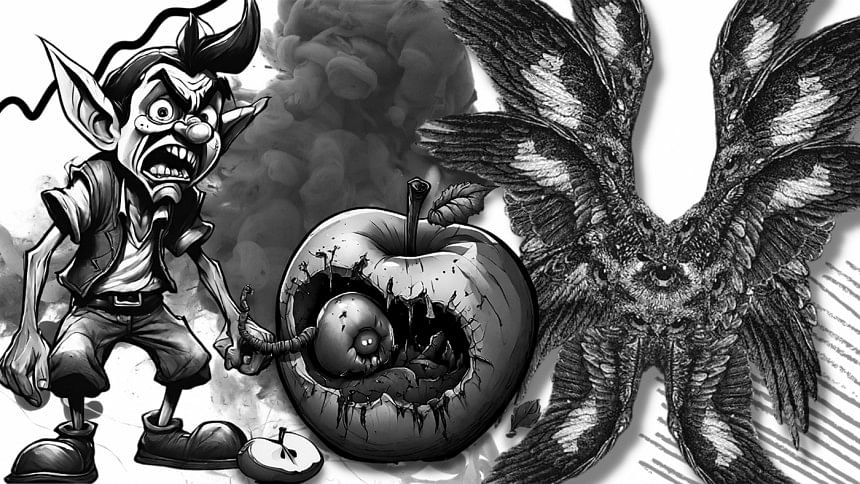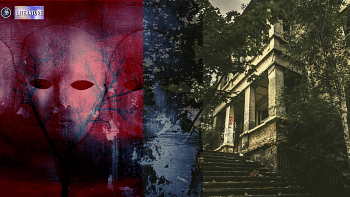The unclassifiable “monsters” of Guillermo Del Toro’s ‘Pinocchio’

Guillermo Del Toro's stop-motion animation, Pinocchio (2022) is loosely based on Carlo Collodi's novel, The Adventures of Pinocchio (1883). The film's striking portrayal of deities as unsettling entities challenges the viewer's past notions of both deities and monsters. It is nothing like Disney's Pinocchio (1940) because instead of the beautiful fairy who has blonde hair, blue eyes, cherry-red lips, rosy cheeks on flawless fair skin, a petite and slender physique, a glittering blue dress, angel wings, a soft-spoken voice, and a magical wand, the viewers of Toro's dark fantasy film will see not one, but two sister goddesses—phantasmagoric, aberrant beings whose grotesque appearances and realms are Kafkaesque even though their attributes and actions are far from being monstrous.
The film is set in Italy, during and after World War I, and a major portion is set during Mussolini's time. It shows us how Geppetto grieves over his dead son, Carlo (a victim of an aerial bombardment), for two decades, until in a state of drunkenness, he cuts down a pine tree and carves an ill-formed, wooden, Frankenstein-esque boy, in a fit of desperation to bring back a semblance of his dead boy.
When master-carver Geppetto passes out, a freakish, blue-feathered deity or wood sprite with multiple pairs of wings and a fishtail appears. Besides being an impossible hybrid—part-mermaid, part-bird, she has myriad eyes on her wings and the extensions protruding from her head. These eyes can dislocate from her body and roam the woods, making her an all-seeing goddess. Her depiction may have been partly inspired from the seraphim, an angelic creature described in Abrahamic religions as having six wings studded with eyes. Her expressionless, pupil-less eyes (the ones that are actually in the place of eye sockets, not the other innumerable ones on her body) are made of bright light and she has an unmoving mouth even when she speaks. This deity with a feminine form gives life to the macabre wooden copy of Carlo, dubbing him Pinocchio.
Later, we witness Pinocchio "dying" many times and each time, he meets the deity of Death, who is an eerier sister of the wood sprite. Death is presented as a sphinx-like/chimaera-like hybrid with a hominoid face, a lion's mane, a buffalo's horns, a lion's body, a pair of majestic wings, and a two-headed snake tail. The gigantic, curled horns and ethereal wings are studded with blinking eyes. She has the same brightly lit, pupil-less eyes and unmoving mouth as her sister. She also has the same voice as her sister—that of the actor Tilda Swinton's, which seems to have been technologically altered to make it entrancing in a non-human way. This blue deity, Death, is surrounded by the sands of time and every time Pinocchio "dies" a temporary "death", his hourglass becomes a little bigger, meaning, he has to wait a little longer to be able to go back to the earthly realm.
The portrayal of the aforementioned deities in Toro's Pinocchio disallows viewers to put them into a certain category, which is where Jeffrey Cohen's third thesis (from his paper "Monster Culture: Seven Thesis") comes in: the monster is the harbinger of category crisis. Are we talking about monsters though? Let's take the goddess of Death into consideration. While she's not monstrous in her actions, she's surely monstrous in appearances, as she's one of the "disturbing hybrids, whose externally incoherent bodies resist attempts to include them in any systematic structuration". The deity of Death is an amalgamation of so many creatures and more: partly humanoid, partly bovine, partly feline, partly avian, partly serpentine, and partly magical. We simply cannot compartmentalise her into a specific category.
Stephen Neale argues that the monster "signifies the boundary between the human and the non-human" and we see this quality of monstrosity in both goddesses in Toro's Pinocchio. Normalcy/naturalness doesn't come to mind. Scientifically and biologically impossible, their physical forms defy logic; classifying them becomes a futile task. They are threatening because they smash distinctions.
It's all the more impossible to understand the conceptual space within which the deity of Death resides, as it's not a realm where any human has gone to and come back from. It's a space where other immortals exist–four black, skeletal rabbits–undertakers of sorts, who have the same pupil-less, brightly lit eyes as the sister deities. These ghoulish rabbits seem to be wearing tailored coats made with their own fur! Furthermore, this realm challenges our expectations of an afterlife described in religious scripture. The dead are simply left abandoned in coffins, there's no depiction of heaven, hell, or purgatory, there's no higher power to judge one's deeds/misdeeds, and the ruler of this realm, aka the deity of Death, sits in her room surrounded by the sands of time. This inability to classify or categorise the feminine deity and her kingdom makes her and her jurisdiction intimidating; after all, we tend to be afraid of the unknown, the alienesque, or the bizarre.
Toro's Pinocchio is quite dark and the deities make it even less child-friendly, despite being an animation film and despite being based on a fairytale. However, neither of the goddesses is cruel/evil, unlike most conventional monsters. While we don't expect the life-giving wood sprite to be monstrous, she's quite horrific to look at, but we do expect her to be kind, like the angelic fairy in Disney's Pinocchio (1940), which she is. Despite her grim appearances, the deity of Death is not the antagonist; she's in fact one who grants Pinocchio a life-changing choice during his final temporary "death"–mortality and a living father over immortality and a dead father. Pinocchio breaks his hourglass in response, giving up his blissful immortality in his urgent and selfless attempt to save his drowning father from the engulfing sea. Unlike portrayals of rulers of the underworld, such as Hades in Disney's Hercules (1997), the deity of Death in Toro's Pinocchio is neither manipulative nor unkind, yet her appearances are nightmarishly deviant. Toro challenges the viewer's preconceived notions of deities and monsters and shows us that the line between them, as far as appearances go, is quite porous, i.e. deities can be as visually unsettling as monsters.
Noora Shamsi Bahar is a senior lecturer at the Department of English and Modern Languages, North South University, and a published researcher and translator.

 For all latest news, follow The Daily Star's Google News channel.
For all latest news, follow The Daily Star's Google News channel. 








Comments